Xiaowen Zhang
SeNM-VAE: Semi-Supervised Noise Modeling with Hierarchical Variational Autoencoder
Mar 26, 2024Abstract:The data bottleneck has emerged as a fundamental challenge in learning based image restoration methods. Researchers have attempted to generate synthesized training data using paired or unpaired samples to address this challenge. This study proposes SeNM-VAE, a semi-supervised noise modeling method that leverages both paired and unpaired datasets to generate realistic degraded data. Our approach is based on modeling the conditional distribution of degraded and clean images with a specially designed graphical model. Under the variational inference framework, we develop an objective function for handling both paired and unpaired data. We employ our method to generate paired training samples for real-world image denoising and super-resolution tasks. Our approach excels in the quality of synthetic degraded images compared to other unpaired and paired noise modeling methods. Furthermore, our approach demonstrates remarkable performance in downstream image restoration tasks, even with limited paired data. With more paired data, our method achieves the best performance on the SIDD dataset.
The Robust Semantic Segmentation UNCV2023 Challenge Results
Sep 27, 2023



Abstract:This paper outlines the winning solutions employed in addressing the MUAD uncertainty quantification challenge held at ICCV 2023. The challenge was centered around semantic segmentation in urban environments, with a particular focus on natural adversarial scenarios. The report presents the results of 19 submitted entries, with numerous techniques drawing inspiration from cutting-edge uncertainty quantification methodologies presented at prominent conferences in the fields of computer vision and machine learning and journals over the past few years. Within this document, the challenge is introduced, shedding light on its purpose and objectives, which primarily revolved around enhancing the robustness of semantic segmentation in urban scenes under varying natural adversarial conditions. The report then delves into the top-performing solutions. Moreover, the document aims to provide a comprehensive overview of the diverse solutions deployed by all participants. By doing so, it seeks to offer readers a deeper insight into the array of strategies that can be leveraged to effectively handle the inherent uncertainties associated with autonomous driving and semantic segmentation, especially within urban environments.
Epsilon*: Privacy Metric for Machine Learning Models
Jul 21, 2023



Abstract:We introduce Epsilon*, a new privacy metric for measuring the privacy risk of a single model instance prior to, during, or after deployment of privacy mitigation strategies. The metric does not require access to the training data sampling or model training algorithm. Epsilon* is a function of true positive and false positive rates in a hypothesis test used by an adversary in a membership inference attack. We distinguish between quantifying the privacy loss of a trained model instance and quantifying the privacy loss of the training mechanism which produces this model instance. Existing approaches in the privacy auditing literature provide lower bounds for the latter, while our metric provides a lower bound for the former by relying on an (${\epsilon}$,${\delta}$)-type of quantification of the privacy of the trained model instance. We establish a relationship between these lower bounds and show how to implement Epsilon* to avoid numerical and noise amplification instability. We further show in experiments on benchmark public data sets that Epsilon* is sensitive to privacy risk mitigation by training with differential privacy (DP), where the value of Epsilon* is reduced by up to 800% compared to the Epsilon* values of non-DP trained baseline models. This metric allows privacy auditors to be independent of model owners, and enables all decision-makers to visualize the privacy-utility landscape to make informed decisions regarding the trade-offs between model privacy and utility.
AIM 2022 Challenge on Instagram Filter Removal: Methods and Results
Oct 17, 2022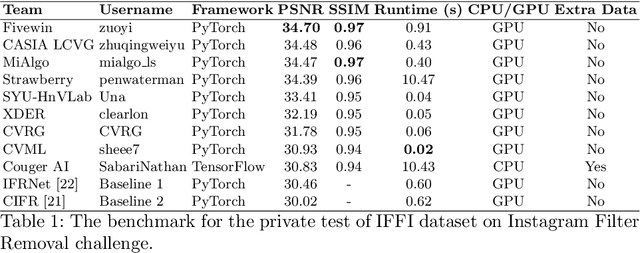
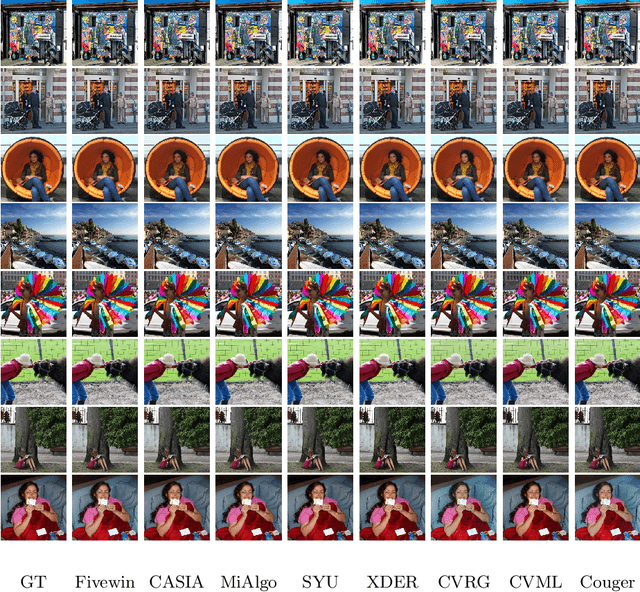
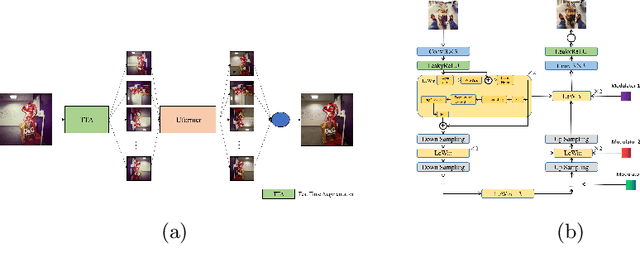
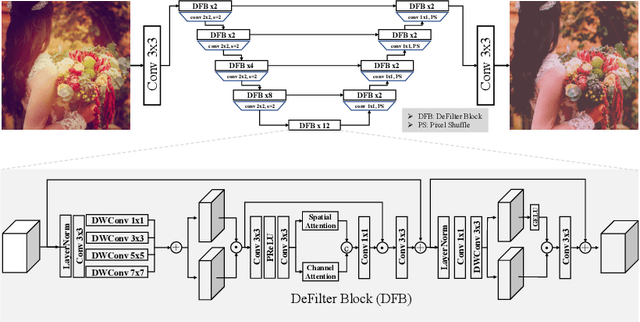
Abstract:This paper introduces the methods and the results of AIM 2022 challenge on Instagram Filter Removal. Social media filters transform the images by consecutive non-linear operations, and the feature maps of the original content may be interpolated into a different domain. This reduces the overall performance of the recent deep learning strategies. The main goal of this challenge is to produce realistic and visually plausible images where the impact of the filters applied is mitigated while preserving the content. The proposed solutions are ranked in terms of the PSNR value with respect to the original images. There are two prior studies on this task as the baseline, and a total of 9 teams have competed in the final phase of the challenge. The comparison of qualitative results of the proposed solutions and the benchmark for the challenge are presented in this report.
EasyRec: An easy-to-use, extendable and efficient framework for building industrial recommendation systems
Sep 26, 2022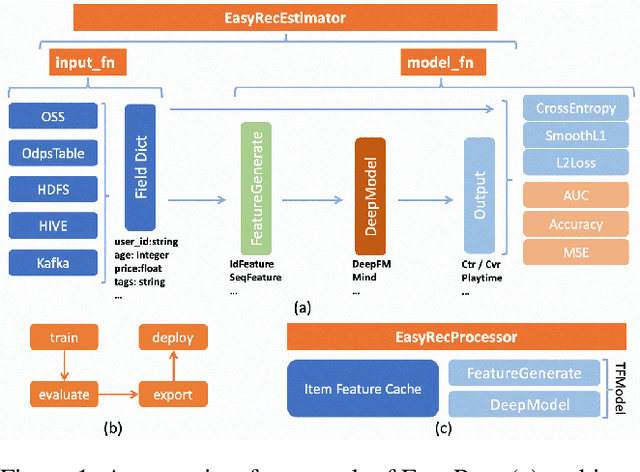
Abstract:We present EasyRec, an easy-to-use, extendable and efficient recommendation framework for building industrial recommendation systems. Our EasyRec framework is superior in the following aspects: first, EasyRec adopts a modular and pluggable design pattern to reduce the efforts to build custom models; second, EasyRec implements hyper-parameter optimization and feature selection algorithms to improve model performance automatically; third, EasyRec applies online learning to fast adapt to the ever-changing data distribution. The code is released: https://github.com/alibaba/EasyRec.
Learn from Unpaired Data for Image Restoration: A Variational Bayes Approach
Apr 21, 2022



Abstract:Collecting paired training data is difficult in practice, but the unpaired samples broadly exist. Current approaches aim at generating synthesized training data from the unpaired samples by exploring the relationship between the corrupted and clean data. This work proposes LUD-VAE, a deep generative method to learn the joint probability density function from data sampled from marginal distributions. Our approach is based on a carefully designed probabilistic graphical model in which the clean and corrupted data domains are conditionally independent. Using variational inference, we maximize the evidence lower bound (ELBO) to estimate the joint probability density function. Furthermore, we show that the ELBO is computable without paired samples under the inference invariant assumption. This property provides the mathematical rationale of our approach in the unpaired setting. Finally, we apply our method to real-world image denoising and super-resolution tasks and train the models using the synthetic data generated by the LUD-VAE. Experimental results validate the advantages of our method over other learnable approaches.
Cross-domain error minimization for unsupervised domain adaptation
Jun 29, 2021



Abstract:Unsupervised domain adaptation aims to transfer knowledge from a labeled source domain to an unlabeled target domain. Previous methods focus on learning domain-invariant features to decrease the discrepancy between the feature distributions as well as minimizing the source error and have made remarkable progress. However, a recently proposed theory reveals that such a strategy is not sufficient for a successful domain adaptation. It shows that besides a small source error, both the discrepancy between the feature distributions and the discrepancy between the labeling functions should be small across domains. The discrepancy between the labeling functions is essentially the cross-domain errors which are ignored by existing methods. To overcome this issue, in this paper, a novel method is proposed to integrate all the objectives into a unified optimization framework. Moreover, the incorrect pseudo labels widely used in previous methods can lead to error accumulation during learning. To alleviate this problem, the pseudo labels are obtained by utilizing structural information of the target domain besides source classifier and we propose a curriculum learning based strategy to select the target samples with more accurate pseudo-labels during training. Comprehensive experiments are conducted, and the results validate that our approach outperforms state-of-the-art methods.
Unsupervised domain adaptation with exploring more statistics and discriminative information
Mar 26, 2020



Abstract:Unsupervised domain adaptation aims at transferring knowledge from the labeled source domain to the unlabeled target domain. Previous methods mainly learn a domain-invariant feature transformation, where the cross-domain discrepancy can be reduced. Maximum Mean Discrepancy(MMD) is the most popular statistic to measure domain discrepancy. However, these methods may suffer from two challenges. 1) MMD-based methods only measure the first-order statistic information across domains, while other useful information such as second-order statistic information has been ignored. 2) The classifier trained on the source domain may confuse to distinguish the correct class from a similar class, and the phenomenon is called class confusion. In this paper, we propose a method called \emph{Unsupervised domain adaptation with exploring more statistics and discriminative information}(MSDI), which tackle these two problems in the principle of structural risk minimization. We adopt the recently proposed statistic called MMCD to measure domain discrepancy which can capture both first-order and second-order statistics simultaneously in RKHS. Besides, we proposed to learn more discriminative features to avoid class confusion, where the inner of the classifier predictions with their transposes are used to reflect the confusion relationship between different classes. Moreover, we minimizing source empirical risk and adopt manifold regularization to explore geometry information in the target domain. MSDI learns a domain-invariant classifier in a unified learning framework incorporating the above objectives. We conduct comprehensive experiments on five real-world datasets and the results verify the effectiveness of the proposed method.
Dual Adversarial Domain Adaptation
Jan 01, 2020



Abstract:Unsupervised domain adaptation aims at transferring knowledge from the labeled source domain to the unlabeled target domain. Previous adversarial domain adaptation methods mostly adopt the discriminator with binary or $K$-dimensional output to perform marginal or conditional alignment independently. Recent experiments have shown that when the discriminator is provided with domain information in both domains and label information in the source domain, it is able to preserve the complex multimodal information and high semantic information in both domains. Following this idea, we adopt a discriminator with $2K$-dimensional output to perform both domain-level and class-level alignments simultaneously in a single discriminator. However, a single discriminator can not capture all the useful information across domains and the relationships between the examples and the decision boundary are rarely explored before. Inspired by multi-view learning and latest advances in domain adaptation, besides the adversarial process between the discriminator and the feature extractor, we also design a novel mechanism to make two discriminators pit against each other, so that they can provide diverse information for each other and avoid generating target features outside the support of the source domain. To the best of our knowledge, it is the first time to explore a dual adversarial strategy in domain adaptation. Moreover, we also use the semi-supervised learning regularization to make the representations more discriminative. Comprehensive experiments on two real-world datasets verify that our method outperforms several state-of-the-art domain adaptation methods.
 Add to Chrome
Add to Chrome Add to Firefox
Add to Firefox Add to Edge
Add to Edge